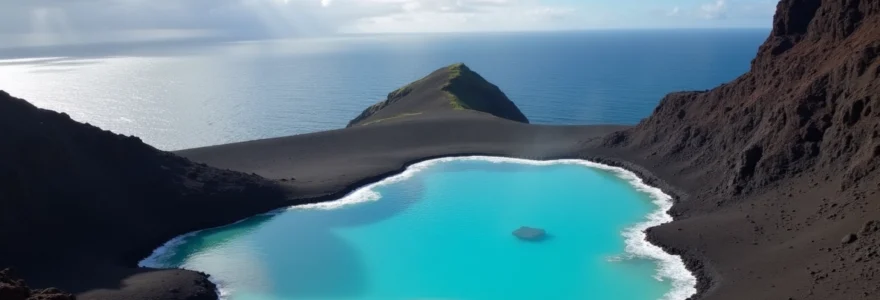The Azores, a remote Portuguese archipelago in the mid-Atlantic, offer a unique blend of volcanic landscapes, thermal wonders, and marine biodiversity. This autonomous region, comprising nine islands, provides visitors with an unparalleled opportunity to explore nature’s raw power and beauty. From scaling dormant volcanoes to soaking in geothermal pools and witnessing majestic marine life, the Azores present a diverse array of experiences that cater to adventure seekers and nature enthusiasts alike.
Geological marvels: exploring azorean volcanoes
The Azores’ volcanic origins have sculpted a dramatic landscape that continues to evolve. These islands serve as a living laboratory for geologists and tourists alike, offering insights into the Earth’s dynamic processes. The archipelago’s volcanic features range from towering peaks to sunken calderas, each telling a unique story of geological formation and transformation.
Hiking mount pico: conquering portugal’s highest peak
Mount Pico, located on Pico Island, stands as the highest point in Portugal at 2,351 meters (7,713 feet). This stratovolcano offers a challenging yet rewarding hiking experience for those seeking to conquer its summit. The ascent typically takes 3-4 hours, with the trail winding through diverse microclimates and offering panoramic views of the surrounding islands.
As you climb, you’ll traverse volcanic scree and witness the gradual change in vegetation. Near the summit, the landscape becomes increasingly otherworldly, with barren volcanic rock dominating the scenery. The crater at the top, known as Piquinho , provides a stark reminder of the mountain’s volcanic nature.
Climbing Mount Pico is not just a physical challenge; it’s a journey through geological time, offering a unique perspective on the forces that shaped these islands.
Caldeira das sete cidades: twin lakes in a volcanic crater
On São Miguel Island, the Caldeira das Sete Cidades presents one of the most iconic views in the Azores. This massive caldera, spanning about 5 km in diameter, houses two distinct lakes: one blue and one green. The contrast in colors, attributed to different algae populations and reflected sunlight, creates a mesmerizing sight that has inspired local legends.
Visitors can explore the caldera through various hiking trails, each offering unique vantage points. The Vista do Rei viewpoint provides a panoramic view of the twin lakes and the surrounding crater walls. For a more immersive experience, you can kayak on the lakes or cycle along the crater rim, allowing for a closer interaction with this geological wonder.
Furnas valley: fumaroles and geothermal activity
Furnas Valley, also on São Miguel Island, showcases the ongoing volcanic activity beneath the Azores. This area is dotted with fumaroles, hot springs, and mud pots, creating a landscape that seems to breathe and steam. The geothermal features here are not just for show; they play an integral role in local culture and cuisine.
One of the unique experiences in Furnas is witnessing the preparation of Cozido das Furnas , a traditional meat stew cooked underground using natural geothermal heat. Pots are buried near the fumaroles in the morning and retrieved several hours later, resulting in a flavorful dish infused with the essence of the Earth.
Capelinhos volcano: witness to recent eruptions
The Capelinhos Volcano on Faial Island offers a stark reminder of the archipelago’s volcanic volatility. Its most recent eruption in 1957-1958 added 2.4 km² of new land to the island, dramatically altering the landscape. Today, the area around Capelinhos resembles a lunar surface, with ash-covered hills and remnants of buildings partially buried by volcanic debris.
The Capelinhos Volcano Interpretation Centre, built underground to preserve the surrounding landscape, provides an immersive educational experience. Through interactive exhibits and multimedia presentations, visitors can learn about the eruption’s impact on local communities and the broader geological context of the Azores.
Thermal wonders: azores’ natural hot springs
The volcanic nature of the Azores has blessed the islands with numerous natural hot springs, offering visitors the opportunity to relax and rejuvenate in mineral-rich waters. These thermal baths, ranging from developed spa facilities to natural pools, provide a unique way to experience the islands’ geothermal energy firsthand.
Poça da dona beija: Iron-Rich thermal pools in furnas
Located in the heart of Furnas Valley, Poça da Dona Beija is a series of five thermal pools known for their iron-rich, reddish-brown waters. The pools vary in temperature, allowing visitors to find their ideal comfort level. Surrounded by lush vegetation, these pools offer a serene setting for relaxation and contemplation.
The high mineral content of the water is believed to have therapeutic properties, particularly for skin conditions and muscle aches. As you soak, you’ll feel the warmth of the Earth seeping into your body, providing a deeply relaxing experience that connects you to the volcanic energy of the Azores.
Caldeira velha: waterfall and hot springs on são miguel
Caldeira Velha, situated on the slopes of the Fogo Volcano, combines the beauty of a natural waterfall with the comfort of thermal pools. This environmental interpretation centre offers visitors a chance to bathe in iron-rich waters while surrounded by dense, subtropical vegetation.
The main attraction is a warm waterfall that cascades into a natural pool, creating a unique hydrotherapy experience. Nearby, smaller pools of varying temperatures allow for a customized thermal bath experience. The lush, steamy environment creates an almost primordial atmosphere, transporting visitors to a time when the Earth was young and volatile.
Terra nostra garden: thermal pool amidst botanical beauty
Terra Nostra Garden in Furnas is a testament to the harmonious blend of human design and natural wonder. This expansive botanical garden, home to a diverse collection of plant species from around the world, features a large, iron-rich thermal pool at its centre.
The pool’s brownish-yellow waters, heated to a constant 35-40°C (95-104°F), offer a unique bathing experience. Surrounded by exotic plants and centuries-old trees, the pool provides a tranquil setting for relaxation. After your soak, explore the garden’s winding paths to discover hidden grottos, exotic flowers, and serene lakes.
Immersing yourself in the thermal waters of Terra Nostra Garden is like stepping into a living painting, where the palette of nature’s colors surrounds you in warmth and beauty.
Ferraria: Ocean-Meets-Thermal-Spring experience
For a truly unique thermal experience, visit Ferraria on the western coast of São Miguel. Here, a natural thermal pool has formed where volcanic hot springs meet the Atlantic Ocean. The temperature of the water varies with the tides, creating a dynamic bathing environment.
During low tide, the pool becomes comfortably warm as the thermal waters dominate. As the tide rises, cool ocean water mixes in, creating an invigorating contrast. This interplay between hot and cold, fresh and salt water, offers a natural hydrotherapy session unlike any other in the Azores.
Marine biodiversity: whale watching in the azores
The waters surrounding the Azores are a haven for marine life, making the archipelago one of the world’s premier whale watching destinations. The islands’ location in the mid-Atlantic serves as a waypoint for migratory species and a permanent home for several resident populations. This rich marine ecosystem offers visitors unparalleled opportunities to observe these magnificent creatures in their natural habitat.
Sperm whale spotting off pico island
Pico Island is renowned for its sperm whale population, which can be observed year-round. These deep-diving giants, made famous by Herman Melville’s “Moby Dick,” frequent the waters around Pico due to the abundance of their preferred prey: giant squid.
Whale watching tours from Pico offer high chances of spotting sperm whales, especially during the summer months. Experienced guides use hydrophones to locate the whales, increasing the likelihood of sightings. Witnessing these majestic creatures breach the surface or raise their distinctive flukes before a deep dive is a truly awe-inspiring experience.
Migrating blue whales in azorean waters
The Azores serve as a crucial stopover for blue whales during their annual migration. These enormous creatures, the largest animals ever to have existed on Earth, can be spotted in Azorean waters typically between March and June. While sightings are less frequent than those of sperm whales, the opportunity to see a blue whale in the wild is an unforgettable experience.
Conservation efforts and responsible whale watching practices in the Azores have helped maintain the archipelago as a safe haven for these magnificent mammals. The islands’ commitment to marine protection has contributed to the continued presence of blue whales in their waters.
Dolphin species: common, bottlenose, and risso’s
The Azores are home to several species of dolphins, offering visitors frequent opportunities for close encounters with these playful marine mammals. Common dolphins, known for their acrobatic displays, are often seen in large pods, sometimes numbering in the hundreds. Bottlenose dolphins, recognizable by their “smiling” appearance, are also regular inhabitants of Azorean waters.
Risso’s dolphins, with their distinctive scarred appearance, are another species frequently spotted around the islands. These encounters provide not just entertainment but also valuable opportunities for marine education and conservation awareness.
Responsible whale watching: best practices and regulations
The Azores have implemented strict regulations to ensure that whale watching activities do not negatively impact marine life. Tour operators are required to follow guidelines that prioritize the well-being of the animals over tourist expectations. These practices include maintaining safe distances, limiting the duration of encounters, and restricting the number of boats near a whale or dolphin pod.
Visitors are encouraged to choose responsible tour operators who adhere to these regulations and contribute to ongoing research and conservation efforts. By participating in responsible whale watching, tourists not only enjoy spectacular wildlife encounters but also contribute to the protection of these magnificent creatures and their habitat.
Island hopping: unique experiences across the archipelago
While each Azorean island offers its own unique charm and attractions, island hopping allows visitors to experience the diverse landscapes and cultures that make up this enchanting archipelago. From underground lava tubes to cascading waterfalls, each island presents distinct opportunities for exploration and discovery.
Terceira island: algar do carvão lava tube exploration
Terceira Island is home to Algar do Carvão, one of the most remarkable volcanic caves in the Azores. This ancient lava tube, formed about 2000 years ago, allows visitors to descend into the very heart of a volcano. The cave’s entrance is a vertical chimney that leads to a large chamber adorned with unique silica stalactites and a crystal-clear lake at its bottom.
Exploring Algar do Carvão offers a surreal experience, as you walk through chambers once filled with molten lava. The cave’s walls, streaked with various mineral deposits, create a natural artwork that tells the story of the island’s fiery past. Guided tours provide insights into the geological processes that formed this underground wonder.
Faial island: capelinhos volcano interpretation centre
The Capelinhos Volcano Interpretation Centre on Faial Island offers a comprehensive look at the archipelago’s volcanic history, with a focus on the dramatic 1957-1958 eruption. This state-of-the-art facility, built underground to preserve the surrounding landscape, uses interactive exhibits and multimedia presentations to bring the eruption to life.
Visitors can learn about the geological forces at work in the Azores, the impact of the eruption on local communities, and the ongoing research into volcanic activity in the region. The centre’s location, adjacent to the ash-covered landscape created by the eruption, provides a tangible connection to the events it describes.
São jorge island: fajãs and coastal cliffs
São Jorge Island is renowned for its dramatic landscape of high cliffs and fajãs – small, flat areas of land at the base of cliffs, formed by lava flows or landslides. These unique geological features have created isolated communities with distinct microclimates, perfect for growing coffee and other crops.
Hiking trails along the island’s spine offer breathtaking views of the coastline and neighboring islands. The trail to Fajã dos Cubres and Fajã da Caldeira de Santo Cristo is particularly popular, leading to isolated settlements where time seems to stand still. These hikes provide not just scenic beauty but also insights into the resilient culture of the Azorean people.
Flores island: cascading waterfalls and lagoons
Flores, the westernmost island of the Azores, is a paradise for nature lovers, boasting an abundance of waterfalls, lakes, and lush vegetation. The island’s interior is dotted with crater lakes, each offering a unique perspective on the island’s volcanic past. The Poço do Bacalhau waterfall, plunging 90 meters into a natural pool, is a highlight for many visitors.
A boat tour around Flores reveals the island’s dramatic coastline, punctuated by towering cliffs and hidden caves. The nearby islet of Monchique marks the westernmost point of Europe, adding a geographical significance to the island’s natural beauty.
Cultural immersion: traditional azorean experiences
Beyond its natural wonders, the Azores offer rich cultural experiences that provide insight into the archipelago’s history, traditions, and way of life. From unique culinary practices to historic cities, the Azores present opportunities for visitors to engage with the local culture in meaningful ways.
Cozido das furnas: geothermally cooked meat stew
Cozido das Furnas is more than just a meal; it’s a demonstration of how Azoreans have adapted to their volcanic environment. This traditional stew, consisting of various meats and vegetables, is cooked underground using natural geothermal heat. Pots are buried near fumaroles in Furnas Valley early in the morning and retrieved several hours later, resulting in a tender, flavorful dish infused with the essence of the Earth.
Witnessing the retrieval of the pots and tasting the resulting stew offers a unique culinary experience that connects visitors to the island’s volcanic nature. Many local restaurants in Furnas offer this dish, often accompanied by stories of its origin and cultural significance.
Pineapple plantations of são miguel
The Azores, particularly São Miguel, are known for their unique pineapple cultivation. Unlike tropical varieties, Azorean pineapples are grown in greenhouses, a practice that dates back to the 19th century. These pineapples, smaller and more aromatic than their tropical counterparts, are a point of pride for local agriculture.
Visiting a pineapple plantation offers insights into the meticulous two-year growing process. Many plantations offer guided tours where visitors can learn about the history of pineapple cultivation in the Azores, the specific techniques used, and even sample pineapple-based products like liqueurs and jams.
Azorean tea plantations: gorreana and porto formoso
The Azores, specifically São Miguel, is home to Europe’s oldest and currently only commercial tea plantations. The Gorreana Tea Plantation and the Porto Formoso Tea Factory offer visitors a unique opportunity to explore the history and process of tea production in a European setting.
These plantations, with their neatly manicured rows of tea bushes set against the backdrop of the Atlantic, provide a picturesque setting for learning about tea cultivation and processing. Guided tours often include a walk through the fields, explanations of the production process, and tea tasting sessions where visitors can sample the distinctive
Azorean black tea varieties.
Visitors can tour the factories to see the traditional machinery still in use and learn about the unique processing methods that give Azorean tea its distinctive flavor. The experience offers a blend of agricultural heritage, scenic beauty, and gastronomic delight.
Angra do heroísmo: unesco world heritage city on terceira
Angra do Heroísmo, the historic capital of the Azores on Terceira Island, stands as a testament to the archipelago’s rich maritime history. Recognized as a UNESCO World Heritage site in 1983, the city’s well-preserved 16th-century architecture and fortifications offer visitors a glimpse into the Azores’ strategic importance during the Age of Exploration.
Wander through the city’s narrow cobblestone streets to discover colorful buildings, ornate churches, and grand palaces. The imposing Sé Cathedral, dating back to the 16th century, dominates the cityscape and offers panoramic views of the harbor from its bell tower. For history enthusiasts, the Museum of Angra do Heroísmo, housed in the former Convent of São Francisco, provides comprehensive insights into the island’s past.
Angra do Heroísmo is not just a city frozen in time; it’s a living museum where centuries of Azorean history and culture converge in a vibrant, modern community.
Don’t miss the opportunity to explore Monte Brasil, a volcanic peninsula connected to the city. This natural fortress, with its 16th-century fortifications, offers hiking trails with stunning views of Angra and the surrounding coastline. The blend of natural beauty and historical significance makes Monte Brasil a perfect representation of what makes the Azores so unique.


